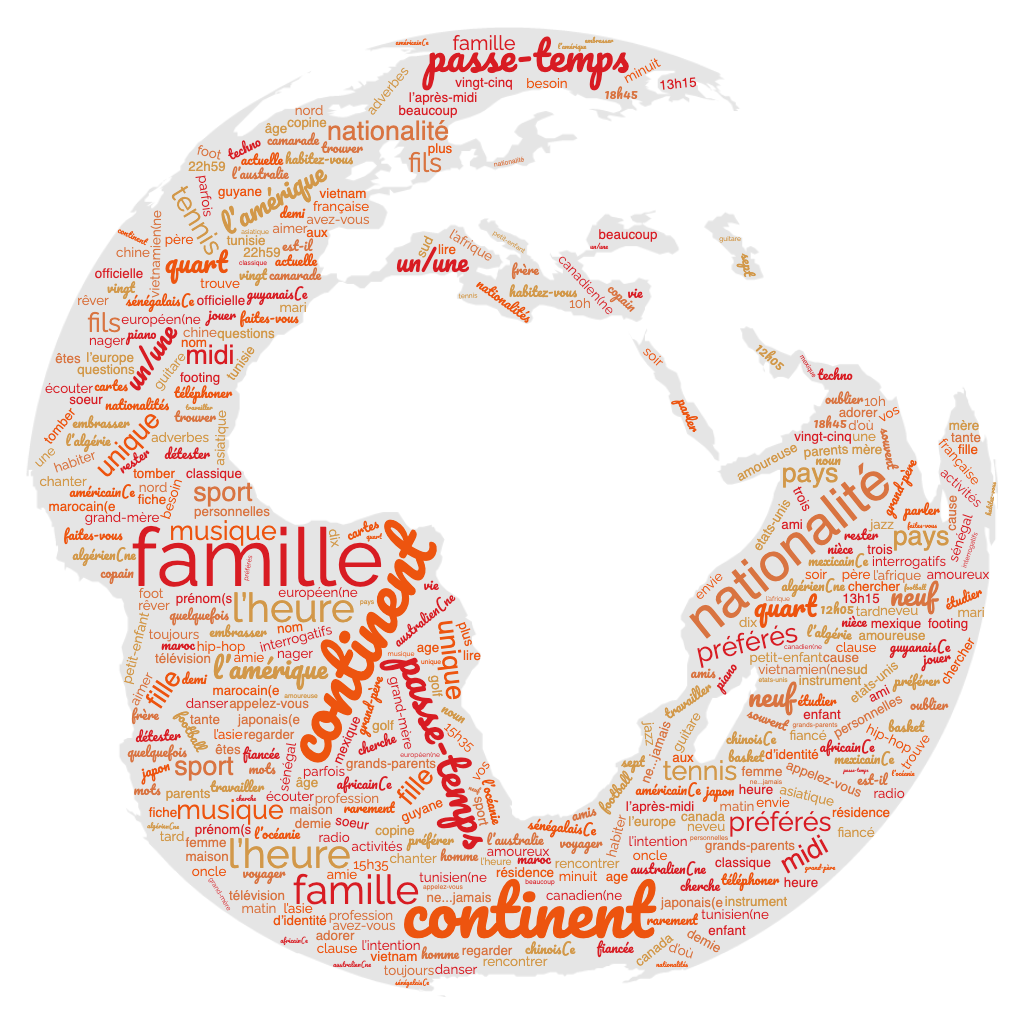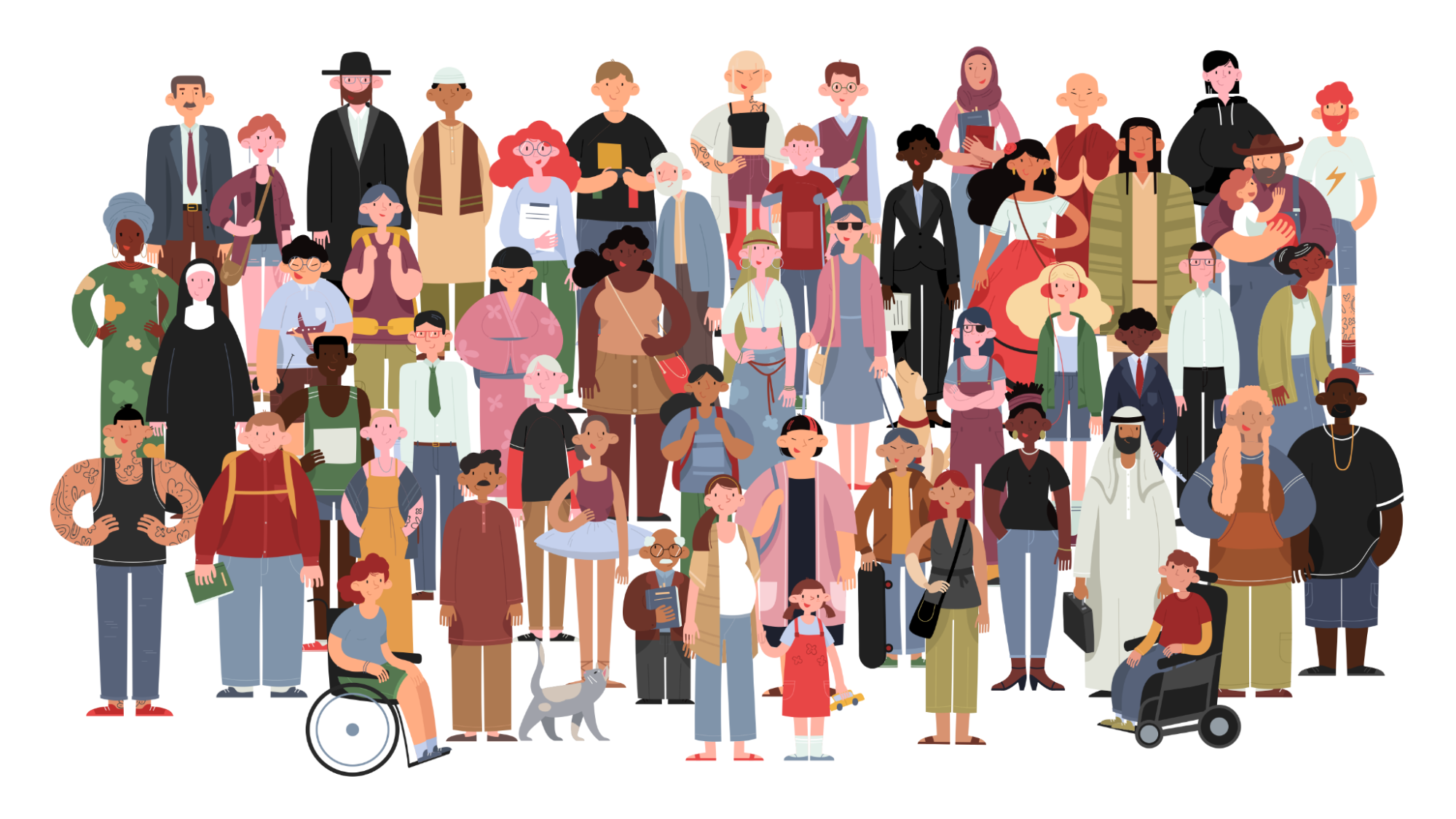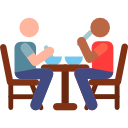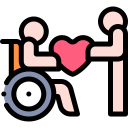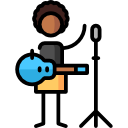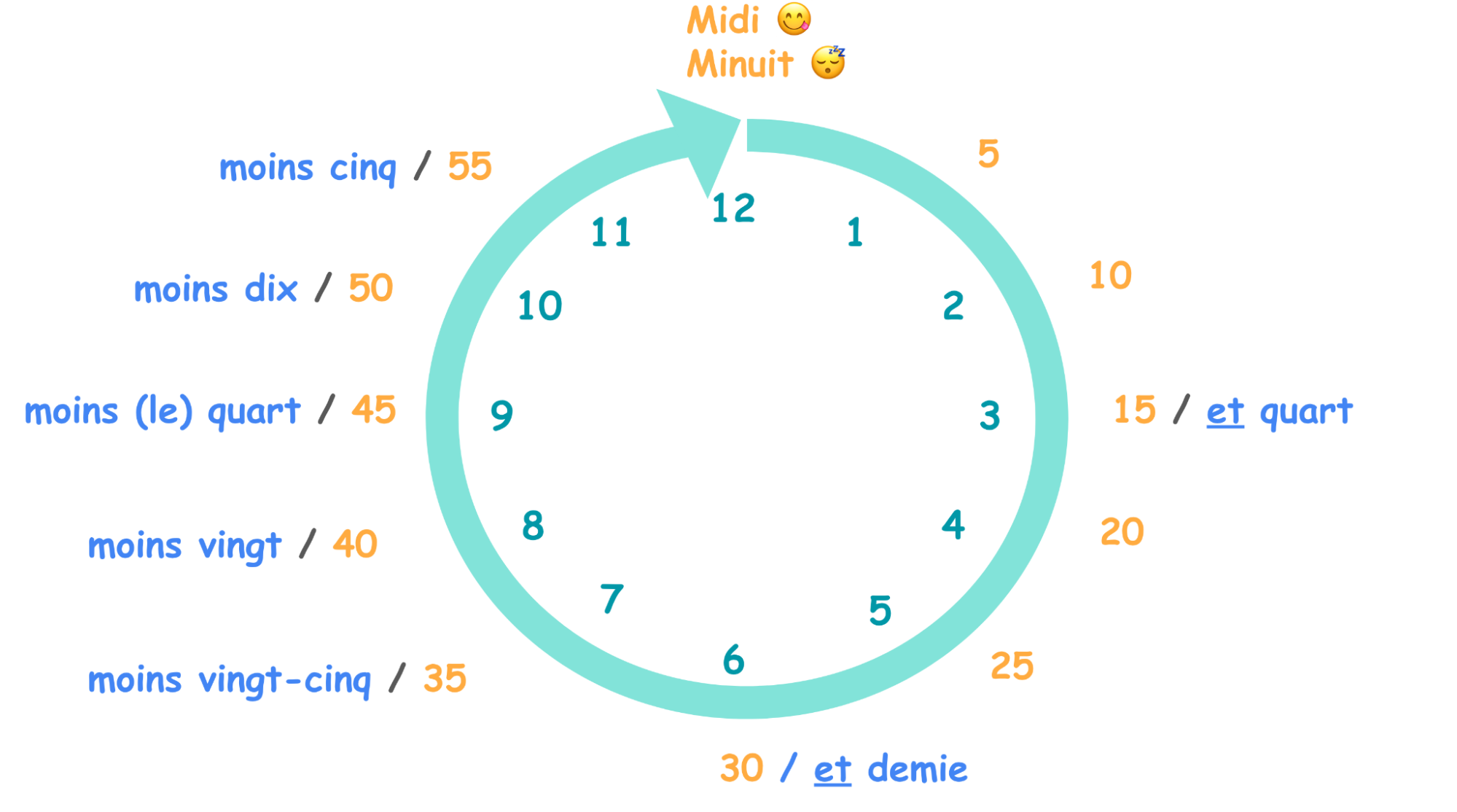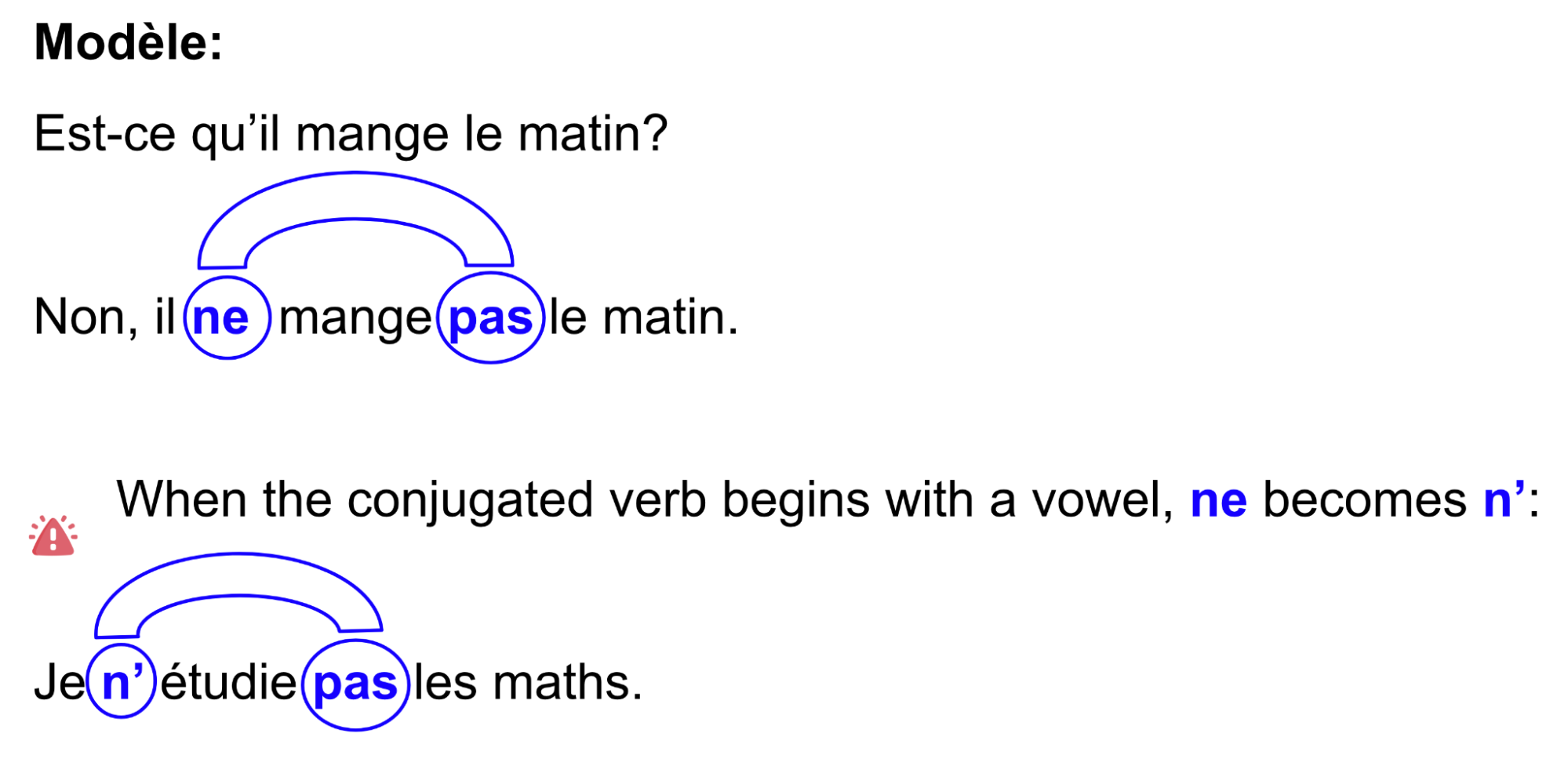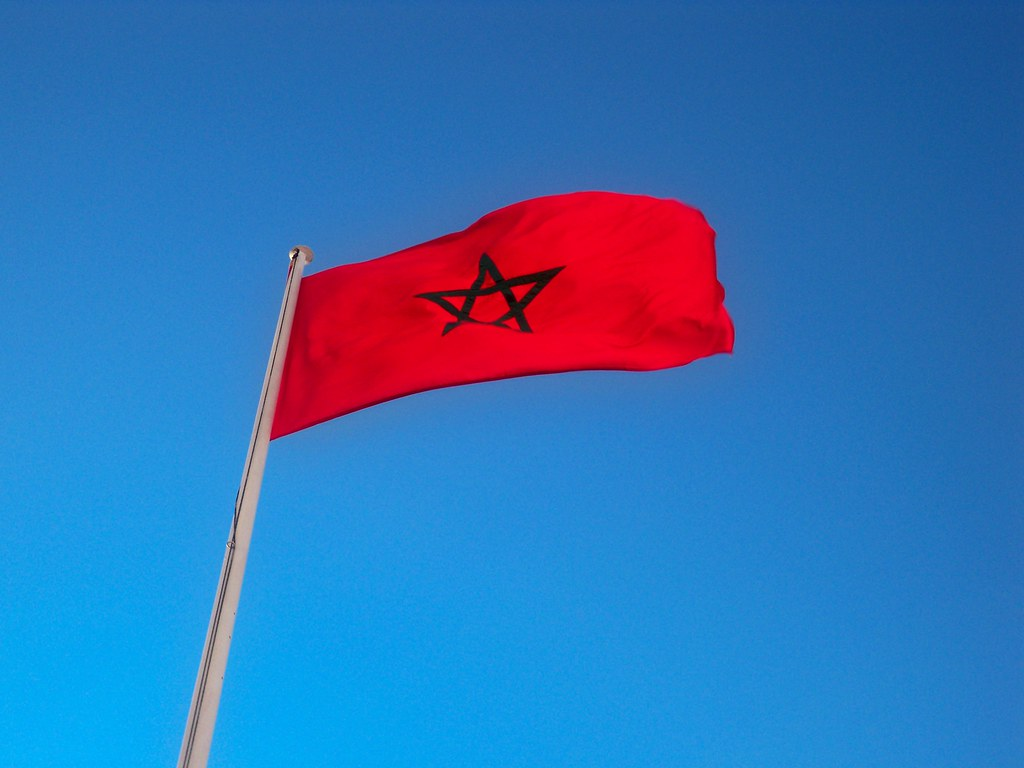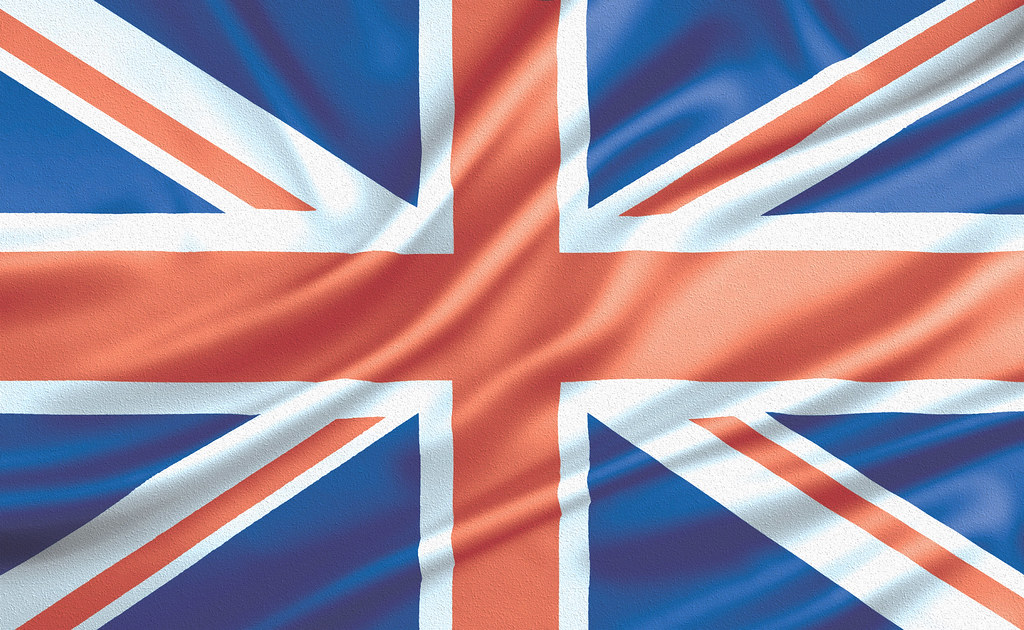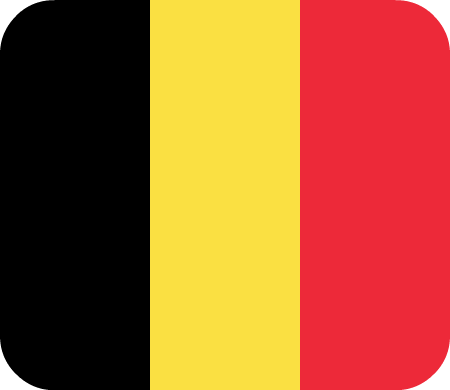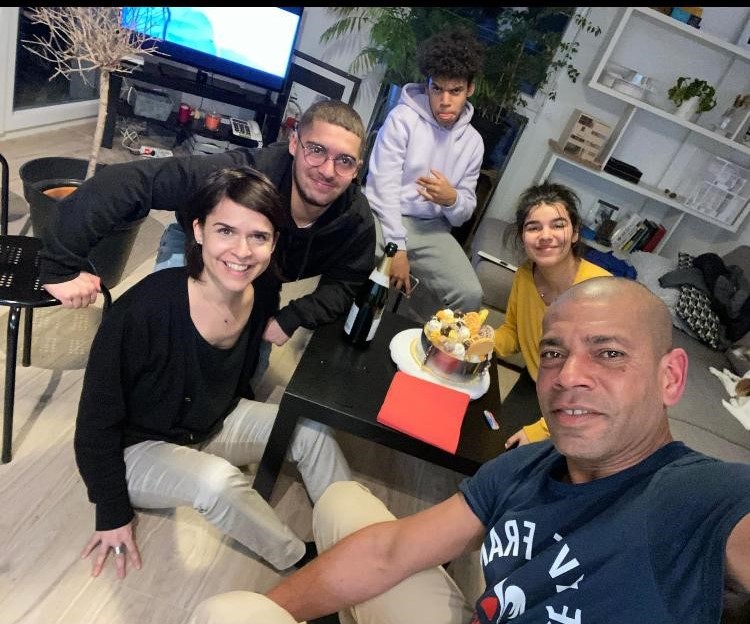2 CH 2 #MonEntourage
Les objectifs du chapitre
In this chapter, you will:
- build your vocabulary to talk about family and relationships in French
- describe your family
- learn and use the verb to have-avoir
- tell what your family members or entourage do (professions, studies, etc.)
- count up to 1000
- learn and use different ways of counting in Francophone countries
- learn and use -ER verbs
- talk about pastime(s) and your family members’ pastime(s)
- ask questions to gather information about someone else
- learn and use English words commonly used and accepted in French
- learn and use interrogative adjectives (quel, quelle, etc.)
- learn and use possessive adjectives (mon, ma, mes, etc.)
- tell time (in official and non-official formats)
- review the days of the week
- review the months of the year
- learn and use yes/no questions (with intonation and est-ce que)
- learn how to form negation in simple sentences
- learn about ne-dropping in spoken French
- learn and use adverbs (souvent, toujours, beaucoup, jamais, etc.)
- learn and use descriptive adjectives and their placement
- name countries and continents
- tell someone about your nationality, and the nationalities of others
- learn about marriage in Switzerland
At the end of the chapter you will revisit this list to self-assess your learning.
 ♦
♦
Week 5 Day 1
La famille et l’entourage de Yasmina
 ♦
♦
1. On se familiarise avec le vocabulaire
Click below for useful vocabulary and activities to get you started with the chapter. Ch 2 On se familiarise avec le vocabulaire
2. On apprend et on écoute – La famille proche (les proches) et la famille élargie (=extended).
Vocabulaire utile : l’Entourage ou la famille

To remember new French words, make handwritten flashcards, stick Post-its with vocabulary around your room, and say the words out loud every time you see them. This combines visual, kinesthetic, and auditory memory strategies—great for retention!
Listen to the audio recorodings as you read the following passages about Yasmina’s family and friends.
Voici la famille de Yasmina.
Yasmina est belge. Elle étudie les sciences politiques à l’Université libre de Bruxelles. Yasmina est fille unique. Le père de Yasmina s’appelle Elias, il est caissier (=cashier). La mère de Yasmina s’appelle Mariam, elle est dentiste. Les parents de Yasmina sont divorcés. Elle a un beau-père, il s’appelle Hugo, il est de Toulouse, France. Le fils de Hugo s’appelle François, c’est le demi-frère de Yasmina. Il est stagiaire à Toulouse. Les grands-parents paternels de Yasmina s’appellent Assi (le grand-père) et Sobia (la grand-mère). Ils sont de Beyrouth au Liban. La mère de Mariam s’appelle Fatima (la grand-mère), elle est de Bruges. Mariam et Hugo sont pacsés. Le chien 🐶 de Yasmina s’appelle Ouafi. La famille élargie de Yasmina est très grande. Elle a beaucoup de (=a lot of) tantes et oncles et 23 cousins et cousines. Les membres de sa famille élargie habitent en Belgique, au Liban et au Maroc. Karine, la meilleure amie de Yasmina, est comme (=like) une sœur.
L’entourage de Yasmina
Les colocataires de Yasmina s’appellent Laura et Stéphanie. Laura est d’Antwerp (en Belgique) et Stéphanie est de Montargis (en France). Laura est coiffeuse et Stéphanie est fleuriste. La meilleure amie de Yasmina est aussi étudiante, elle s’appelle Karine. Elle est aussi de Bruges et est aussi étudiante mais (=but) à Montréal. Les voisins de Yasmina. Ils sont dix. Il y a un couple, Olivier et Bruno, ils sont mariés et sont une famille recomposée. Olivier a deux enfants et Bruno trois. Il y a aussi Claude, iel est célibataire. Le chien 🐶 de Claude s’appelle Arthur et le chat 🐱 s’appelle Kit. Voilà la famille et l’entourage de Yasmina.
Practice
Do you remember all the names and relationships in Yasmina’s extended family? Let’s check.
How did you do? Keep listening to the texts or read them out loud yourself to practice your French pronunciation and help your brain retain the new vocabulary.
Was it easier the second time? Do you think your comprehension improved after listening to the texts multiple times? Practice always makes better 😉
3. On apprend et on pratique
Vocabulaire utile : les mots interrogatifs
Now that you’ve learned how to talk about family and relationships, what if you wanted to ask someone about theirs? 🤔 Which question words would you use?
Let’s dive into the most common French question words to help you start meaningful conversations!
Practice
Here are some questions someone might ask about Yasmina’s family. Try to match the question words from the list with the questions, and give appropriate answers based on what you already know about her family. Don’t worry if this activity feels challenging — you’ll learn much more about how to ask questions later in the chapter. Have fun and see if your guesses are spot on!
Keep on practicing. As they say in French, “Paris ne s’est pas fait en un jour!” (Paris was not made in a day!), it takes time to build new skills and knowledge.
Is Yasmina’s family similar to yours? In what ways?
 As we address the notion of family, we all have different circumstances, and our notion of family might differ from others. What is ‘family’ to you?
As we address the notion of family, we all have different circumstances, and our notion of family might differ from others. What is ‘family’ to you?
For the remainder of the chapter, feel free to use personal examples, create a fictional idea of ‘your’ family or use a well-known family.
4. Carnet personnel✍️
 Time to take out our personal journal to work on describing your family. In your journal, please provide the following information in table form. Use your own family for reference or one famous family you mentioned above. Add rows as needed! Start with yourself, as in the model below:
Time to take out our personal journal to work on describing your family. In your journal, please provide the following information in table form. Use your own family for reference or one famous family you mentioned above. Add rows as needed! Start with yourself, as in the model below:
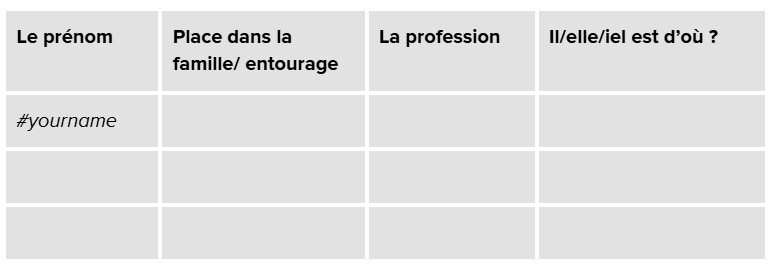
Now that you have this table completed, try to descriobe your family in a paragraph form. Here is an example.

Voici l’âge des personnes de la famille de Yasmina. Can you make own sentences replacing the people in parenthesis with people that are relevant to you?
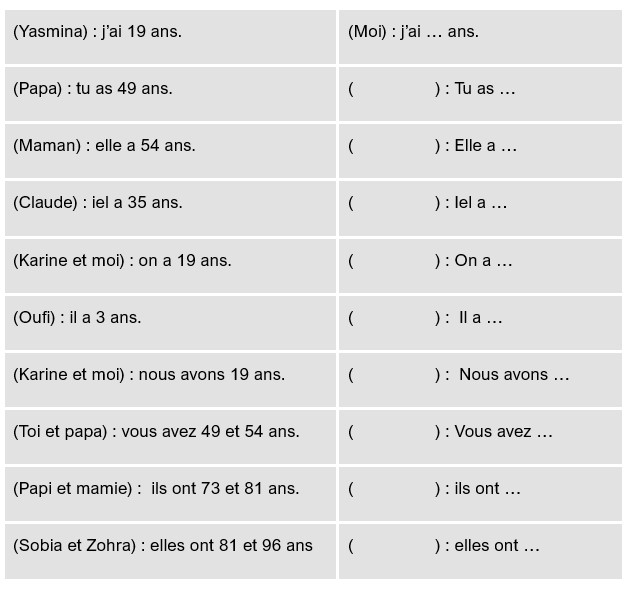
5. On découvre : le verbe avoir
In Yasmina’s family description that was presented earlier, you were introduced to two forms of the verb avoir : ont (plural) and a (singular): Les parents d’Elias (Assi et Sobia) ont 73 et 81 ans. Zohra, l’arrière-grand-mère de Yasmina, a 96 ans.
“Avoir” means “to have” in French. It’s one of the most important and frequently used verbs in the language. The verb avoir comes from Latin. Its root is “habere”, which also meant “to have” or “to hold.” Over time, Latin evolved into Old French, and habere became avoir. Write down by hand the conjugation of avoir in your Carnet personnel✍️:
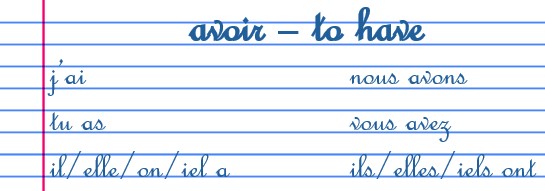
To learn more, go to #Grammaire #Avoir. Lisez les explications et complétez les activités : avoir ‘to have’.
Practice
Ready to sing and memorize the conjugation of avoir?
Singulier ou pluriel ?
Écoutez et décidez si le verbe est au singulier ou au pluriel.
Écoutez une deuxième fois et faites cet exercise.
Où sont les verbes ?
Voici Samia. Complétez les phrases suivantes avec le verbe avoir.
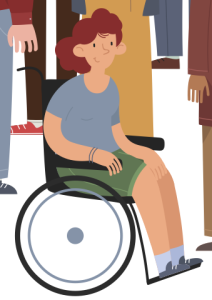
5. Social Media Frenches: #MaFamille (optionel)
![]() Go to Instagram and search separately for #MaFamille and #MyFamily.
Go to Instagram and search separately for #MaFamille and #MyFamily.
Describe the differences you see in how the concept of family is illustrated in Anglophone cultures versus Francophone cultures. Do you see any pictures that represent your own conceptualization of family?
 ♦
♦
Week 5 Day 2
Une famille, trois générations
 ♦
♦
1. On apprend : les nombres cardinaux de 70 à 1000
Le vocabulaire utile : les nombres cardinaux (la suite)
Before we start to learn new numbers, review those up to 69 (Chapter 1).
Now let’s learn how to say numbers from 21 to 1,000:
2. On lit
♦♦ Variations sociales : Compter en français dans le monde francophone
In francophone Switzerland and Belgium, Congo, the numbers for 70 and 90 are septante and nonante. Only in Switzerland is 80 – huitante. They follow the rest of the Romance languages by combining a root word from Latin for 7 (sept), 8 (huit) or 9 (neuf) with a root word from for ten (-tente/a) , e.g. settanta ‘seventy’ (Italian: sette + anta), noventa ‘ninety’ (Portuguese: nove + enta).

Modèle :
70 = septante
81 = huitante et un
92 = nonante-deux
France follows a different system which is vigesimal (=base 20) from 70-99. The system is mixed due to North Germanic influence, first appearing in Normandy, in northern France. From there, it spread south after the formation of the French Republic, replacing the typical Romance forms still used today in Belgian and Swiss French. The current vigesimal system was introduced by the Vikings and adopted by the Normans who popularized its use (e.g. In English, four score and seven = 87). Pre-Roman Celtic languages in Gaul also made use of a vigesimal system, but this system largely vanished early in French linguistic history or became severely marginalized in its range. The Nordic vigesimal system may possibly derive ultimately from the Celtic (Wikipedia).

For more information on the topic, check out: Compter en français de 0 à 99, les différents systèmes, les différences culturelles – Le français illustré
Modèle :
70 = 60 + 10 = soixante-dix
71 = 60 et 11 = soixante-et-onze [Attention – irregular pattern]
72 = 60 + 12 = soixante-douze
80 = 4*20 = quatre-vingts
81 = 4*20 + 1 = quatre-vingt-un [Attention – irregular pattern]
82 = 4*20 + 2 = quatre-vingt-deux
90 = 4*20 + 10 = quatre-vingt-dix
91 = 4*20 + 11 = quatre-vingt-onze
92 = 4*20 + 12 = quatre-vingt-douze
What does the counting system for tens (10, 20, 30, 40,…90) look like in the other languages you speak? Is the system predictable? Are there multiple ways to count? Does it incorporate counting systems from other languages? Which ones? Why do you think Congo has the same counting system as Belgium? Which Francophone system do you prefer and why?
According to the Académie française and modern French grammar rules, numbers from 17 to 99 (except for round tens like 20, 30, etc.) are typically written with hyphens between all parts. Sometimes, numbers are still written without hypens. After the 1990 French spelling reform, it became standard to use hyphens between all parts of compound numbers, making forms like soixante-dix officially correct. Pay attention to how numbers are written next time you read an article in a French newspaper or a novel.
There is another rule that can help you with French numbers – when does one add “s” to cent and mille?
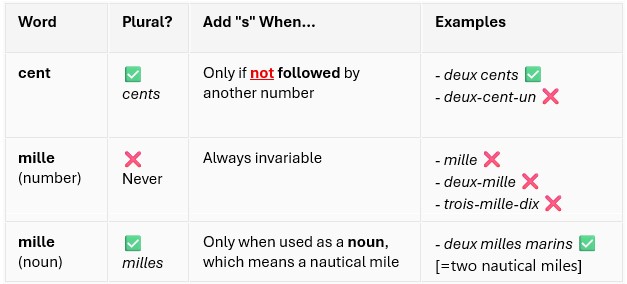
If you’re curious to dive deeper into the rules for cent, mille, and other number-related grammar in French, here are some excellent resources:
-
- Polyglottist Language Academy – French Number Agreement
A detailed guide to when and why to add “s” to cent and vingt, with clear examples and exceptions. - About-France.com – French Numbers and Counting
Covers everything from basic numbers to millions, including spelling, hyphenation, and regional differences. - Lawless French – Numbers and Counting: 100 and Up
A learner-friendly breakdown of how to use cent, mille, and million, with pronunciation tips and audio.
- Polyglottist Language Academy – French Number Agreement
Here is a table with French numbers from 70 to 1000:
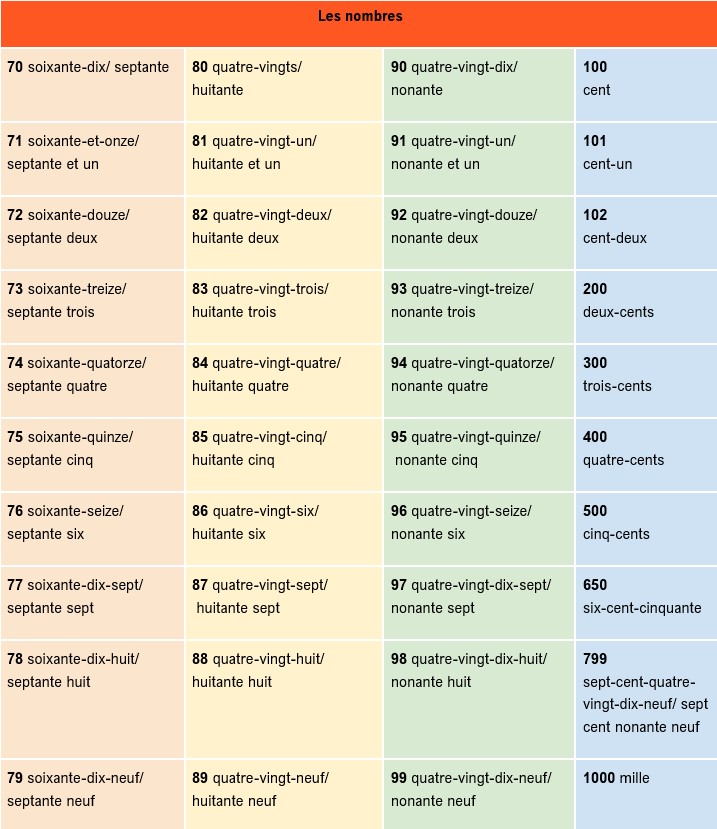
In Chapter 1, you saw how learning other languages can help you build skills that are useful in any job—like being a better communicator, understanding different cultures, and adapting to new situations. Now, in Chapter 2, you’re just discovering that even something as simple as counting or measuring things can be done differently around the world. That’s a big deal! It shows that people don’t all experience the world the same way, and learning about those differences helps you become more flexible in your thinking and better at solving problems.
And here’s something cool: even though French is spoken in the Francophone countries, it’s not exactly the same everywhere. Some places have changed the rules or even invented new words to make French fit their own culture and way of life. So just because it’s all “French” doesn’t mean it’s all the same. That’s part of what makes learning a language so interesting—it’s not just about words, it’s about people and how they live.
website: https://www.naceweb.org/career-readiness/competencies.
 To really connect with people in another language, you need to talk about the things that matter most—like your family and friends. That’s why learning numbers up to 1,000 is so important. It helps you share and understand ages, birthdays, and even fun facts like how many cousins you have or how old your grandparents are. We often talk about age because it helps us get to know each other better—it gives context, shows respect, and sometimes even sparks stories or memories.
To really connect with people in another language, you need to talk about the things that matter most—like your family and friends. That’s why learning numbers up to 1,000 is so important. It helps you share and understand ages, birthdays, and even fun facts like how many cousins you have or how old your grandparents are. We often talk about age because it helps us get to know each other better—it gives context, shows respect, and sometimes even sparks stories or memories.
So, being able to say how old someone is in French is more than just a number—it’s a way to build relationships.
3. On écoute – Une famille, trois générations.
Yasmina a 19 ans comme Karine sa meilleure amie, mais (=but) Yasmina est née (=was born) le 2 décembre et Karine est née le 4 avril. Son père, Elias, a 49 ans, Sa mère, Mariam, est plus âgée (=older), elle a 54 ans. Son partenaire, Hugo, a 53 ans. Les parents d’Elias, Assi et Sobia, ont 73 et 81 ans. Zohra, l’arrière-grand-mère de Yasmina, a 96 ans. Elle est veuve, c’est la plus vieille (=the oldest) de la famille. Ouafi est le plus jeune (=youngest), il a 3 ans.
4. Carnet personnel✍️
Now it’s your turn to write a paragraph about your family and three generations, using Yasmina’s text as a model.
👨👩👧👦 Ma famille, trois générations
Lis le texte sur Yasmina et sa famille. Ensuite, écris un paragraphe similaire sur ta propre famille. Parle de :
- Ton âge et celui (=that one, i.e. the age) de ton/ta meilleur(e) ami(e)
- Les âges de tes parents paternels et/ou maternels (ou d’autres adultes importants)
- Les membres les plus âgés et les plus jeunes de ta famille
Écris les nombres en lettres pour pratiquer leur prononciation. Voici un modèle supplémentaire :
Ma mère a quarante-cinq ans. Mon père est plus jeune, il a quarante-deux ans. Mon grand-père paternel s’appelle Paul, il a quatre-vingts ans. Ma grand-mère maternelle s’appelle Marie. Elle a quatre-vingt-un ans. Le plus jeune, c’est mon petit frère. Il a quatre ans.
✨ Pour aller plus loin (optionnel)
💬Dialogue imaginé.
Imagine a dialogue between you and one of your classmates. Your classmate will ask you the following questions, and you will respond with your own answers. Don’t forget to read the questions and your answers out loud—role-playing is a great way to practice pronunciation and build confidence when speaking French! Also remember that copying these questions by hand in your personal journal helps you memorize the language and makes it easier to remember key vocabulary and sentence structures.
X: Dans ta famille, comment s’appelle la personne la plus âgée ?
Y: C’est …
X: Qui est-ce dans la famille ?
Y: C’est …
X: Quel âge a-t-elle ?
Y: Il/Elle/Iel a …. ans.
X: Comment s’appelle la personne la plus jeune ?
Y: C’est …
X: Qui est-ce dans ta famille (ton cousin, ta cousine, le chat, etc. ) ?
Y: C’est …
X: Quel âge a-t-elle ?
Y: Il/Elle/Iel a …. ans.
The word ‘une personne’ is always feminine : Marc est une personne intelligente/ Sophie est une personne intelligente/ Iel est une personne intelligente. Using ‘personne’ is an easy way to talk about nonbinary people that avoids ‘femme’, ‘fille’, ‘garçon’.
🌳 Mon arbre généalogique
Now that you’ve practiced talking about age and family, try creating a simple family tree (in Word or simply draw it by hand) that includes your grandparents (maternal and paternal), parents, and siblings or cousins. This helps you use numbers up to 1,000 in a real way—like giving ages or birth years—and lets you explore how to describe family relationships in French. It’s a fun way to connect language learning with your own life and see how numbers tell stories about the people you care about.
5. On calcule et on révise : Avoir vs. être
Have you memorized how to conjugate the verb être ? You can review it here : être ‘to be’ What about the verb avoir? You can review it here : avoir ‘to have’
Practice
We know the ages of Yasmina and her family. Imagine that today is July 14, 2025. Based on this date, calculate the year each person would have been born. Be sure to use the correct verb—avoir (to express age) or être (to say when someone was born)—depending on the context. Pay attention to subject-verb agreement, especially for gender and number.
6. On apprend : les années
Understanding how to form numbers in French will help you say years like 1991 or 2007 when talking about when someone you know was born.
In French, years are typically pronounced using a structure based on thousands and hundreds. For example, 1991 is said as “mille-neuf-cent-quatre-vingt-onze”, which literally translates to “thousand nine hundred ninety-one,” with quatre-vingt-onze meaning “ninety-one” (literally “four-twenty-eleven”). For years in the 2000s, the format changes slightly: 2007 is pronounced “deux-mille-sept”, meaning “two thousand seven.” This pattern continues for most years after 2000, using deux-mille (2000), deux-mille-un (2001), and so on. The key difference is that years before 2000 use mille + number, while years from 2000 onward use deux-mille + number.
One can say “dix-neuf cent quatre-vingt-onze” for 1991, and it would be understood, but it’s considered less formal and less standard than “mille-neuf-cent-quatre-vingt-onze”. This alternative form mimics how years are often said in English (e.g., “nineteen ninety-one”) and is sometimes used in casual speech, songs, or media for rhythm or stylistic reasons. However, in formal contexts, such as news broadcasts, academic settings, or official documents, “mille-neuf-cent…” remains the preferred and more grammatically correct form. So while “dix-neuf-cent…” is not incorrect, it’s relatively infrequent and more colloquial.
If you’d like to dive deeper into French big numbers—including the nuances of using large numbers with or without the indefinite article un (meaning ‘one’), the symbols used for decimal points and thousands, and when to add or omit an -s at the end—there’s a lot of fascinating detail to explore. This comprehensive video by Marvelous French on how to say French numbers from 1,000 to one trillion answers all these questions in English, while clearly pronouncing the numbers in French!
Let’s practice how to ask questions and answer them in French ! Here is an imagined dialogue between two people. Listen to the audio several times to hear all the numbers.
X: Mark, tu es né en quelle année ?
M: Je suis né en 1988. J’ai 37 ans. Comme on dit, je fais partie de la Génération Y.
X: En quelle année est née ta personne préférée dans ton entourage ?
M: Mon copain est né en 1991. Il a 34 ans. Comme moi, il fait partie de la Génération Y.
X: Ta mère est née en quelle année ? Et ton père ?
M: Maman est née en 1967. Elle a 58 ans. Elle fait partie de la Génération X.
Papa est né en 1963, il a 62 ans. C’est la génération des Baby-Boomers.
X: Ta fille est née en quelle année ?
M: En 2007. Elle a 18 ans, elle fait partie de la Génération Z.
X: C’est quand son anniversaire ?
M: C’est le 14 juillet, comme la fête nationale française.
X: Tu as un fils?
M: Oui, il est né en 2011. Il a 14 ans. Il fait partie de la Génération Alpha.
X: Quelle famille et combien de générations !
Now, let’s see if you can pronounce the same dates correctly.
Regardez les années qui correspondent aux différentes générations:
Can you write all these numbers in words?
7. On révise avec Camille Chevalier (optionnel)
To review and practice how to pronounce French Numbers 1 to a Billion (with audio recordings & quiz at the end), go to the site created by Camille Chevalier for FrenchToday: On apprend comment prononcer les nombres.
 ♦
♦
Week 5 Day 3
Les passetemps et les activités
 ♦
♦
1. On apprend
Vocabulaire utile : les passe-temps et les activités
2. On observe : les verbes en -ER
Les étudiants de l’Université Internationale de Casablanca au Maroc pratiquent les activités suivantes. Trouvez la phrase correcte pour chaque image.
a. b. c. d. e. f.
g. h. i. j. k. l.
3. On apprend – Le verbe danser
In French, regular -er verbs are the most common type of verbs and belong to what is known as the first group of verbs. They follow a predictable pattern in the present tense. To conjugate them, you remove the -er ending from the infinitive to get the stem, then add the appropriate endings: -e, -es, -e, -ons, -ez, -ent for the first, second, and third person in both singular and plural forms. For example, the verb parler (to speak) becomes je parle, tu parles, il/elle parle, nous parlons, vous parlez, ils/elles parlent. In spoken French, four of these verb endings—-e, -es, -e, and -ent—are pronounced the same!, which means that the verbs in je parle, tu parles, elle parle, and ils parlent all sound alike [paʀl].
This is how one conjugates the verbe danser which belongs to this group. Remember to write down by hand the conjugation of danser in your Carnet personnel✍️

To learn more, go to #Grammaire #-er verbs present tense. Lisez les explications et complétez les activités : -er verbs (regular) present tense and -er verbs (stem changing) present tense
Practice
Écoutez et décidez si le verbe est au singulier ou au pluriel. Attention, parfois il est impossible à distinguer si le verbe est au singulier ou au pluriel.
Écoutez une deuxième fois et écrivez le pronom et le verbe.
4. On prononce : les symboles phonétiques, l’élision et la liaison
The verb endings for the 3rd person singular (#4) and 3rd person plural forms (#6) are pronounced the same, i.e. they are both silent. This is true for all regular -ER verbs. When a verb starts with a vowel or h-muet (a silent h), you must make a liaison, i.e. pronounce a [z], if the preceding word pronoun ends in an -s, e.g. vous_[z]_avez, elles_[z]_aiment, nous_[z]_adorons. Don’t forget to consult this site, if you have more questions about les symboles phonétiques.
Listen to the conjugation of the verbe aimer – to like, to love where you hear the liaison with nous, vous, and ils forms:
5. Carnet personnel✍️
Time to write in your personal journal.
Lis chaque question et écris une réponse complète en français dans ton Carnet personnel. Utilise “Oui, je…” ou “Non, je ne…” pour répondre.
You can listen to the questions to practice your listening comprehension while you practice your written communication.
Modèle:
Question : Est-ce que tu téléphones souvent à ton meilleur ami / ta meilleure amie ?
Réponse : Oui, je téléphone souvent à ma meilleure amie Sophie./ Non, je ne téléphone pas souvent à mon meilleur ami Matt.
-
-
- Est-ce que tu postes des photos sur Instagram ?
- Est-ce que tu joues au foot ?
- Est-ce que tu détestes la politique ?
- Est-ce que tu aimes étudier ?
- Est-ce que tu voyages beaucoup ?
- Est-ce que tu joues d’un instrument de musique ?
- Est-ce que tu chantes ?
- Est-ce que tu adores le hip-hop ?
- Est-ce que tu écoutes des podcasts ?
- Est-ce que tu aimes danser?
-
6. On pratique : Quel verbe choisir ?
Practice
Conjuguez les phrases avec le verbe logique: aimer, avoir, écouter, étudier, habiter, jouer, nager, préférer, rencontrer, voyager
If you doubt how to conjugate a French verb, check out Conjugaison de tous les verbes avec Le Conjugueur or Bescherelle Conjugaison | Le conjugueur Bescherelle, la référence en conjugaison !
7. On découvre : les Jeux Olympiques (optionnel)
Les Jeux Olympiques
Step 1. Before consulting the schedule for the 2022 Winter Olympic games, consider the following questions.
- Do you usually follow the Winter Olympic games? Why or why not?
- If you do, what is your favorite sport to watch? Least favorite?
- What kind of sports and activities do people practice in your country / region in the winter?
- What kind of vocabulary would you expect to need to understand the information in the document?
- The document is titled “Pekin 2022.” What is another name for Pékin?
Step 2. Now look at the picture below and answer the following questions in French
- On est dans quel pays ?
- Combien de personnes sont sur la photo ?
- Combien de sports sont représentés ?
- C’est quel mois ?
Step 3. Scan the information on the document Pekin 2022.pdf to find answers to the following questions. Don’t worry if you don’t understand every word of the text. You will discuss your responses with your group.
Note all the cognates (English, Spanish or any other language) that you found in the text, did you find a lot? Does that surprise you, why or why not?
- What do the letters F and H stand for in French?
- All the times listed are based on France time (GMT +01:00). What is your country’s / state’s time zone? Now, imagine that you want to watch the Biathlon which is at 10:00 in France. What time will it be where you live?
- What sports can you watch on February 13?
- Vocabulary: use a dictionary of your choice (Dictionnaire Français-Anglais en ligne – Larousse or Dictionnaire Français-Anglais WordReference.com or equivalent) and look up the gender and English translation of the following words. Remember that you are in the context of sports when identifying the translations.
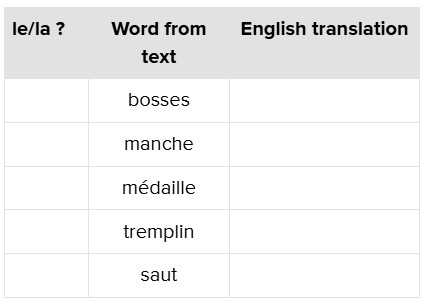
- The text uses the following abbreviations. Write the full-length word in French next to each one (review from CH 1):

Step 4. Read the article about anglicisms at the Olympics: CH 2 Le breakdancing_ French Olympic planners plot to end the invasion of the English language _ CNN.pdf
Identify three sports words mentioned in the article that come from English that don’t have French equivalents.
What do you think about this statement in the article: “All living languages exist by borrowing from each other, it is an asset. Languages only exist thanks to their impurity.”
Step 5. If you would like to explore the Paris 2024 Olympic and Paralympic Games, please visit the official website: https://www.olympics-paris2024.com/fr/
 ♦
♦
Week 6 Day 1
Questions personnelles
 ♦
♦
1. On rencontre de nouvelles personnes
Now that you’ve learned -er verbs and numbers, you’re ready to take the next step: meet new people and ask personal questions. Today, you’ll begin by listening to two short interviews with French students from the University of Texas at Austin. Pay close attention to how they introduce themselves and talk about their lives—this will help you learn how to ask and answer personal questions in French.
- Meet Stéphanie. Listen to this short interview where she answers personal questions about her age, nationality, hobbies, and more. Reconstitute the order of the sentences you hear.
- Meet Virginie. After having listened to this short interview, write down the missing information.
2. On découvre : les adjectifs interrogatifs et possessifs
To ask personal questions in French, you need to learn more about two types of French adjectives: interrogative and possessive. Interrogative adjectives like quel, quelle, quels, and quelles are used to ask questions such as “Which book?” or “What movie?”, and they must agree in gender and number with the noun they describe. Possessive adjectives like mon, ma, mes (my) and ton, ta, tes (your) show ownership, but unlike English, they also change depending on the gender and number of the noun—not the owner. Learning these adjectives is important because they help you ask questions and talk about what belongs to whom, which are essential skills for everyday communication in French.
Imagine this scenario – you meet Yasmina and she introduces herself. Here is what she could say. Are you ready to follow her example?
C’est moi, Yasmina. Mon nom est Benyounes et mon prénom est Yasmina. Ma nationalité est belge. Mon adresse est 25 Rue du Bourg à Bruxelles. Mes passe-temps préférés sont tricoter (=knit) et texter mes amis. J’aime aussi regarder les JO 😉. Et toi?
In your Carnet personnel✍️, write down the following information:
1. Mon nom est …
2. Mon prénom est …
3. Ma nationalité est …
4. Mon adresse est …
5. Mes passe-temps préférés sont …
Practice
Sometimes, we can ask the same question in different ways. Can you match the equivalent questions from the left column by dragging them into the correct cells on the right?
Look at the questions in the right column. What do you think quel means? How can you explain the difference between quel – quelle – quels – quelles?
To learn more about interrogative and exclamative quel, go to #Grammaire #Quel Lisez les explications et complétez les activités : interrogative and exclamative quel
Here is a quick visual summary of these rules:
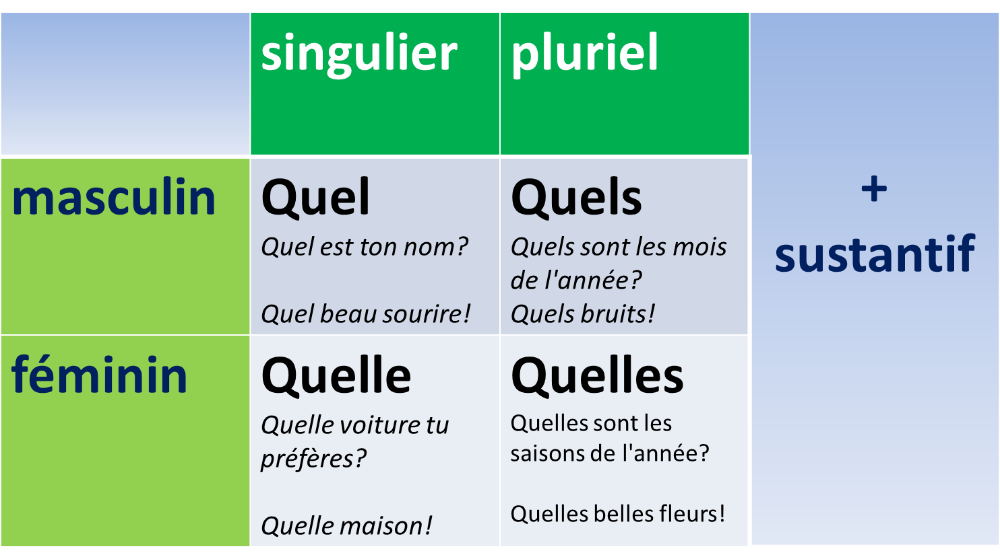
To learn more about possesive adjectives, go to #Grammaire#LesAdjectifsPossessifs Lisez les explications et complétez les activités : possessive determiners
Here is a quick visual summary of these adjectives:
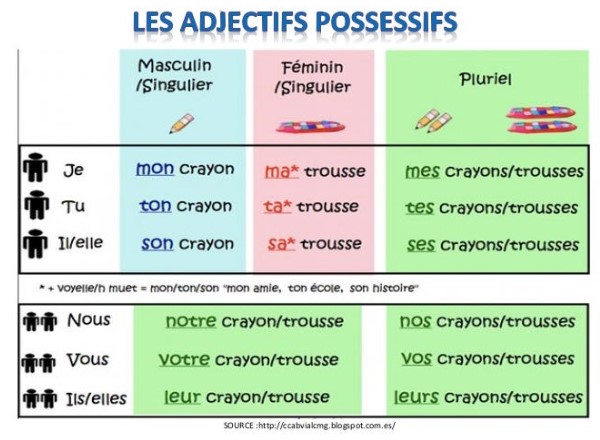
Practice
La famille de Yasmina Benyounes est grande. Dans les phrases suivantes, elle décrit les activités des membres de sa (=her) famille. Choisissez la bonne phrase pour chaque situation.
Donnez la forme correcte des adjectifs possessifs. Attention : parfois, deux réponses sont possibles. Par exemple, mon pays et mes pays sont tous les deux corrects, parce que cela dépend si l’on parle d’un seul pays ou de plusieurs. Le mot pays se termine par un s, donc la forme au singulier est identique à la forme au pluriel. En plus, le mot prof (abréviation de professeur) peut être masculin ou féminin, selon la personne dont on parle.
Comment dit-on ? Donnez la traduction en français des expressions suivantes:
3. Carnet personnel ✍️
In Week 5, Day 1 you’ve seen how Yasmina describes both her close and extended family. Use her example as a model to help you think about your own family or the people around you. In your personal journal, write a short description of your family or your circle—this could include relatives, close friends, or anyone important in your life. Think about how to introduce them in French using what you’ve learned so far. You can also create a visual representation of your family and friends, just like the one shown in the picture below.
To expand on what you may have already written in your journal, think about the hobbies and favorite activities of your family and friends. Choose at least five people and write full sentences describing what they like to do.
Maintenant, pensez à votre entourage et choisissez cinq personnes . Qu’est-ce que les membres de votre entourage aiment faire (=to do)? Ecrivez 5 phrases.
Modèle : Ma mère aime écouter des Podcasts.
You can always explore more sites on how to speak about hobbies in French. For instance, How To Talk About Your Hobbies In French gives a great list of common activities. Or you may find this handout helpful – Lesson 21 – Hobbies and leisure activities. Or use this visual organizer – Les activités sportives et les loisirs.
4. On lit
♦♦ Variations sociales : Les anglicismes
Like all languages, French actively borrows words and expressions from other languages and cultures. This is because languages are always in contact with one another, across geopolitical boundaries, in virtual spaces, and in the minds and mouths of the multilinguals who use them.
Many borrowings come from the sharing of cultural practices and technological advances in a globalized world. Un anglicisme (=anglicism) is a word used to describe an English word that has come into a variety of world French.
Here are some examples of anglicisms and their era of introduction into French:
- 18th century: un grog, un club, un bifteck, un meeting, le punch, le spleen
- 19th century: un leader, un cocktail, un coach, un speech, un smoking (=smoking jacket), un cowboy
- 20th century: un weekend, un/une babysitter, le hip-hop, un/des jean/s, un hot dog, parquer, bloguer
- 21st century: un/des legging/s, un hashtag, tweeter (=to tweet), un coming-out, une start-up
Not all varieties of French adopt and use anglicisms in the same way. This is because different parts of la Francophonie have different viewpoints surrounding borrowing from outside languages. Government agencies whose mission is to slow language change often try to discourage the use of new words and expressions from outside sources by proposing new French equivalents that have been engineered from French or Latinate (Latin is the mother language of French) parts. But because languages are as living and breathing as the people who speak them, these attempts to stave off borrowing that is the result of natural cultural contact are rarely successful in the long term.
French in Quebec is perhaps the most regulated language in the world. This is because they have implemented strict laws to promote the continued use of French in a geographic space where all surrounding neighbors are anglophone. For that reason, anglicisms are viewed more critically in these spaces than in other parts of la Francophonie where the contact with English-speaking cultures is less intense. You can observe this firsthand by looking at the usage rates of certain English borrowings in the francophone world and comparing them to the usage rates in Quebec.
For example, in France, the English borrowings le mail (=email), le smartphone, and le marketing have become widely used terms, while in Quebec, speakers often opt for the prescribed engineered French-based equivalents le courriel (=courri(er) él(ectronique)), le téléphone intelligent and le mercatique. À chacun son goût !
Make a list of words and expressions in your language that are borrowed from other languages and cultures. Which language has contributed the most borrowed words to other languages, and what might be the reasons behind this high borrowing rate?
To read more about anglicisms in the Francophone world, visit:
5. On écoute et on pratique
Practice
Regardez les vidéos de Stéphanie, Virginie et Karen parler de leur famille et écrivez ou trouvez les informations manquantes.
Virginie talks about her big family.
Finally, here is Karen’s interview.
6. On s’éclate en chanson !
Écoutez et regardez le clip vidéo suivant et répondez aux questions : Black M – Mama (Clip officiel) ft. Sidiki Diabaté.
7. 🎬On explore la culture francophone à travers le film ! (Optionnel)
Watching films in French is a fun and powerful way to support your language learning—even if you’re just starting out! Hearing real voices, everyday expressions, and cultural references helps you get used to the rhythm and sounds of the language. You don’t need to understand every word—just listening and watching with subtitles can improve your comprehension, vocabulary, and pronunciation over time. Plus, films give you a window into French-speaking cultures and daily life that textbooks can’t always show.
Here are some film suggestions related to modern family life—a great way to review and reinforce new vocabulary while enjoying authentic French culture 😉
-
- La Vraie Famille (The Family, Dir. Fabien Gorgeart, 2022). A moving story about foster care, love, and the emotional complexity of letting go. 📺Official trailer
-
- C’est quoi cette famille ?! (We Are Family, Dir. Gabriel Julien-Laferrière, 2016). A comedy about a boy navigating life with multiple stepparents and a blended family. 📺Official trailer
-
- La Famille Bélier (The Bélier Family, Dir. Éric Lartigau, 2014). A heartfelt comedy-drama about a girl who serves as the interpreter for her deaf family. 📺Official trailer
-
- Le Petit Nicolas (Little Nicholas, Dir. Laurent Tirard, 2009). A nostalgic and humorous look at childhood and family life in 1950s France. 📺Official trailer
-
- Papa ou Maman (Daddy or Mommy, Dir. Martin Bourboulon, 2015). A comedy about a divorcing couple who both try to avoid custody of their children. 📺Official trailer
 ♦
♦
Week 6 Day 2
Quelle heure est-il? Il est quelle heure ?
 ♦
♦
Le vocabulaire : L’heure
1. On apprend : l’heure, l’heure officielle et le temps
In French, l’heure refers to the specific time of day (e.g., Quelle heure est-il ?), while l’heure officielle means the 24-hour clock format often used in formal settings like train schedules or school timetables. On the other hand, le temps can mean either the weather (Quel temps fait-il ?) or time in a general sense, like duration (Je n’ai pas le temps). Each word has a distinct use, so it’s important to pay attention to context!
In French, “il est” is used to tell the time, similar to saying “it is” in English. For example, “Il est huit heures” means “It is eight o’clock.” This phrase is always used when giving the time, followed by the number of hours and, if needed, minutes. It’s a simple and essential structure for talking about daily routines, schedules, and appointments.
Time expressions often include parts of the day to clarify whether it’s morning, afternoon, or evening. Use “du matin“ for times between midnight and noon, “de l’après-midi“ from noon to around 6 p.m., and “du soir“ from about 6 p.m. to midnight. These phrases are especially important when using the 12-hour clock, as they help avoid confusion between a.m. and p.m. In French, “pile“ is used to indicate that the time is exactly on the hour, with no minutes past. It’s similar to saying “on the dot” or “exactly” in English.
Look at the times in these four different cities. How would you say what time it is in each one—in French?

-
-
- Il est quelle heure à Seattle ? Il est midi = Il est 12 heures.
- Quelle heure est-il à Genève ? Il est 9 heures (du soir) = Il est 21 heures.
- Quelle heure est-il à Perth ? Il est 4 heures (du matin) = Il est 4 heures.
-
L’heure officielle
En français, on utilise le système horaire sur 24h (jusqu’à 23:59). Le système sur 24h est le plus utilisé dans le monde. Comment on utilise le système sur 24h ? C’est facile (=it’s easy) c’est 12 + X : 1 heure = 13h (12+1), 2h = 14h (12+2), 3h = 15h (12+3), etc. There are two ways of writing time in French, i.e. 3h10 = 15h10.
|
L’heure |
Le système sur 24h |
Le système sur 12h |
|
12:00pm |
Il est douze heures. |
Il est midi. |
|
12:15pm |
Il est douze heures quinze. |
Il est midi et quart. |
|
12:20pm |
Il est douze heures vingt. |
Il est midi vingt. |
|
12:30pm |
Il est douze heures trente. |
Il est midi et demie. |
|
12:35pm |
Il est douze heures trente-cinq. |
Il est une heure moins vingt-cinq. |
|
12:40pm |
Il est douze heures quarante. |
Il est une heure moins vingt. |
|
12:45pm |
Il est douze heures quarante-cinq. |
Il est une heure moins (le) quart. |
|
12:50pm |
Il est douze heures cinquante. |
Il est une heure moins dix. |
|
12:55pm |
Il est douze heures cinquante-cinq. |
Il est une heure moins cinq. |
|
1:00pm |
Il est treize heures. |
Il est une heure (pile). |
2. On pratique
Practice
Listen to this video to practice and memorize how to say time in French.
You can also listen to this song on YouTube: Quelle heure est-il ?
Can you write down all the times you hear in this recording?
How about distinguishing between a.m and p.m. in French? But remember, you do not say a.m and p.m. in French 😉!
Can you write the non-official time for the following official times?
3. On écoute et on écrit
 Listening and writing are key to learning a language. They activate different areas of the brain, helping you process and remember the language more effectively.
Listening and writing are key to learning a language. They activate different areas of the brain, helping you process and remember the language more effectively.
Listening helps you understand how words sound and how sentences flow. Writing helps you remember vocabulary and grammar. When you do both—like in a dictation—you improve your comprehension and spelling at the same time.
Practice
How about a little #dictogloss?
Now you’re ready for something even more challenging—a dictation!
Dictation is a great way to check if you remember how to write academic subjects and time expressions correctly. Below is a full 100-word dictation. First, listen to the entire text. Even if it feels difficult, don’t worry—keep pushing yourself! As they say in French: Qui ne risque rien, ne boit pas de champagne! 🍾
Now, write it down phrase by phrase.
4. À quelle heure ?
You just listened to Yasmina’s schedule as a dictation to practice telling time and identifying school subjects. Now, you’ll look at a new version of her schedule, presented as a calendar. This activity will help you build new skills: reading and interpreting authentic materials, gathering specific information, and answering comprehension questions based on real-life formats. Pay close attention to the days, times, and activities to complete the questions that follow!
Voici l’emploi du temps de Yasmina ce semestre. Observez et répondez aux questions.
* bosser (familiar) = travailler
4. On révise : les jours de la semaine et les mois de l’année
Here’s a great site to review the days of the week and months of the year in French, with vocabulary lists and interactive exercises:
🌐 TV5MONDE – Vocabulaire : les mois, les jours, etc.
You can also watch these two short videos to practice pronouncing the days of the week and the months of the year in French.
5. Carnet personnel✍️
In Chapter 1, you already created a calendar with your schedule. Now, go back to it and add more details, just like Yasmina did—include times when you have coffee or lunch with friends, when and where you work, and any fun activities you do, like dancing, swimming, or jogging. Maybe you meditate in the morning 🧘 or do stretches at night 🧎?
This is your chance to personalize your calendar and reflect your daily routine more fully!
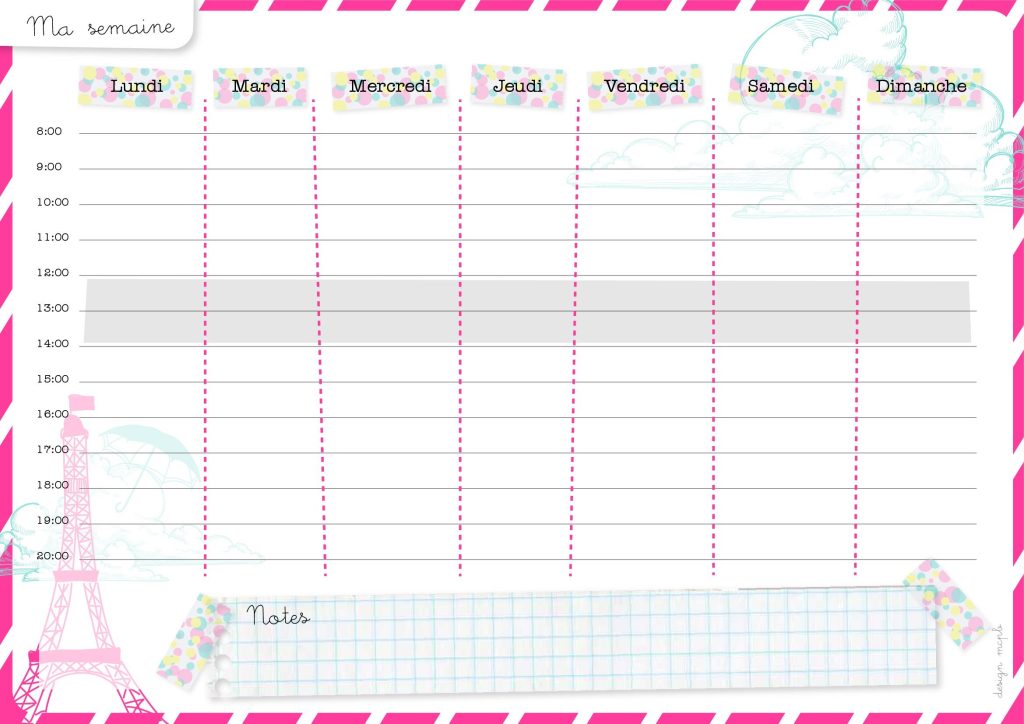
As you fill out your calendar, practice using -er verbs in the present tense to describe your routine. For example:
- Je médite le matin.
- Je travaille au café le weekend.
- Je mange avec mes amis l’après-midi.
- Je danse le soir.
- Je fais du yoga la nuit.
Use complete sentences to describe your day and reinforce your verb conjugation skills! Also, remember to include the exact times of day when you do your activities—this will help reinforce the vocabulary you’ve just learned for telling time. Here are some questions that can help you capture more details in your schedule:
En général :
- À quelle heure est-ce que tu étudies ?
- À quelle heure est-ce que tu écoutes des podcasts ?
- À quelle heure est-ce que tu regardes Netflix / Hulu / etc. ?
- À quelle heure est-ce que tu manges l’après-midi et le soir ?
- Est-ce que tu manges seul(e) ou avec des amis ?
- À quelle heure est-ce que tu téléphones à tes parents ?
- À quelle heure est-ce que tu étudies le français ?
Ta routine :
- As-tu une routine du matin ? Que fais-tu le matin ?
- As-tu une routine du soir ? Que fais-tu le soir ?
Et le week-end ?
- Que fais-tu le week-end ? Tu travailles ? Où ?
 ♦
♦
Week 6 Day 3
Les questions et la négation
 ♦
♦
1. On apprend : les questions oui/non
There are several ways to form questions in French. We will first learn how to make yes/no questions that use the same word order as declarative sentences, e.g. subject + verb + object.
One way to form a question is to use a rising intonation at the end of the statement instead of a falling one:
↘ ↗
Tu étudies le soir. (= statement) vs. Tu étudies le soir? (= question)
Another way to form yes / no questions is to use the question marker est-ce que (=is it (the case) that) at the beginning of the sentence.
Est-ce que tu étudies le soir?
Practice
Questions avec l’ intonation. Transformez les phrases suivantes, à l’oral, en questions en employant l’intonation montante (=rising intonation).
Modèle : Mariam et Hugo sont pacsés. ↗ Mariam et Hugo sont pacsés?
Questions avec est-ce que. Maintenant (=now) transformez les mêmes (=same) phrases en questions avec est-ce que.
Modèle: Mariam et Hugo sont pacsés → Est-ce que Mariam et Hugo sont pacsés ?
If you want to dive deeper into the subject of how to ask questions in French, consult Camille Chevalier’s lesson on 40 French Question Words + How to Ask Questions in French.
2. On analyse : La négation
The questions above are called yes/no questions and will have either an affirmative or negative answer. In French you need two words to negate a sentence, ne and pas (=not). The two words are placed around (before and after) the conjugated verb.
To learn more about negation, go to #Grammaire #LaNégation. Lisez les explications et complétez les activités : basic negation: ne … pas
Practice
Try to answer all of these questions using negation—can you say “no” to each one?
3. On lit
♦♦ Variations sociales : Ne-dropping
One of the ways that French is currently changing is through the way it marks negation. In written French, the two-part system ne…pas placed around the conjugated verb is preferred. However, in spoken French, the tendency is to drop the ne and only use the second part, e.g. Je ne suis pas (written) > Je suis pas (spoken). Ne-dropping has been attested in French since the 16th century and has become more prevalent over time. All varieties of French exhibit
ne -dropping conditioned by stylistic factors: the more formal the situation, the more likely speakers are to use ne in their speech.
You might wonder why this change is happening. We don’t always know the exact reason for all the changes that languages undergo, but in this case, we do. Before the two-part ne…pas system, French behaved like other Romance languages and marked negation through just the use of ne placed before the verb, e.g. Je ne suis (compare with preverbal no in Spanish and Italian; nu in Romanian; não in Portuguese).
In the 17th century, French began adding an emphatic element that came after the verb to reinforce the ne. Modern day pas comes from the Latin word PASSUM ‘step’; the addition of the second part was often used with verbs of motion, e.g. je ne marche pas ‘I don’t walk a step’. As the pas began to lose its emphatic meaning, it became associated with the negation it once emphasized, freeing the ne up to be readily deleted.
Here’s a video on “ne” dropping in everyday spoken French, a common feature of informal conversation. It’s part of Comme une Française, a YouTube channel and podcast created by Géraldine Lepère, a native French speaker. Her channel is a true gem for learners—full of clear explanations, practical tips, and authentic expressions. Save this link and explore more: https://www.youtube.com/@Commeunefrancaise
4. On révise : quel/le/s, questions, négation et possessifs
Practice
Donnez la bonne forme de quel à chaque question : quel, quelle, quelles ou quels
Posez des questions avec quel pour obtenir les informations suivantes :
In this activity, you’ll put everything together!
You’ll practice conjugating verbs in the present tense, using negation (ne…pas), and choosing the correct possessive adjectives based on context. Read each sentence carefully and fill in the blanks with the correct forms.
 ♦
♦
Week 7 Day 1
Les nationalités, les pays et les continents
 ♦
♦
1. On apprend : les adverbes
Vocabulaire utile : les adverbes
 The French sentence “Il m’aime un peu, beaucoup, passionnément, pas du tout, jamais !” playfully expresses the range of emotions someone might feel in love. It comes from a traditional game where a person plucks daisy petals while saying phrases like “a little,” “a lot,” “passionately,” “not at all,” and “never,” hoping the last petal reveals how much someone loves them. It’s similar to the English game “He loves me, he loves me not,” but with more dramatic and poetic options.
The French sentence “Il m’aime un peu, beaucoup, passionnément, pas du tout, jamais !” playfully expresses the range of emotions someone might feel in love. It comes from a traditional game where a person plucks daisy petals while saying phrases like “a little,” “a lot,” “passionately,” “not at all,” and “never,” hoping the last petal reveals how much someone loves them. It’s similar to the English game “He loves me, he loves me not,” but with more dramatic and poetic options.
Un peu, beaucoup, passionnément, pas du tout et jamais sont des adverbes. Qu’est-ce que c’est un adverbe ?
#Grammaire #Adverbes Lisez les explications et complétez les activités : les adverbes (introduction)
Practice
In the following sentences, identify the adverbs. :
Indicate how often you do each of the following activities using one of these adverbs: jamais(never), rarement(rarely), souvent(often), un peu (a little), beaucoup(a lot), or toujours(always). After completing the list, take a screenshot to share with your instructor or classmates.
Now, put it all together. In this dialogue between two cousins, Yamsina and Samia, find the appropraite question words from this chapter (qui, quand, comment, où, quel…) and appropriate adverbs from the previous list (jamais, pas du tout, rarement, souvent, un peu, beaucoup, toujours).
2. On découvre: les nationalités, les pays et les continents
Le vocabulaire utile : les nationalités, les pays et les continents
Est-ce que vous voyagez souvent ? Jamais, un peu, beaucoup, toujours ? Dans mes rêves (=dreams), je visite souvent le Japon. Et vous, quel pays est-ce que vous visitez dans vos rêves ?
To talk about nationalities and use adjectives to describe geographical origins, you first need to learn the basics of French adjectives. To get started, go to #Grammaire #Adjectives Lisez les explications et complétez les activités : introduction to adjectives and also #Grammaire #AdjectivesPlacement Lisez les explications et complétez les activités : adjectives: formation and placement
Here are two visual summaries of the basic rules for French descriptive adjectives:
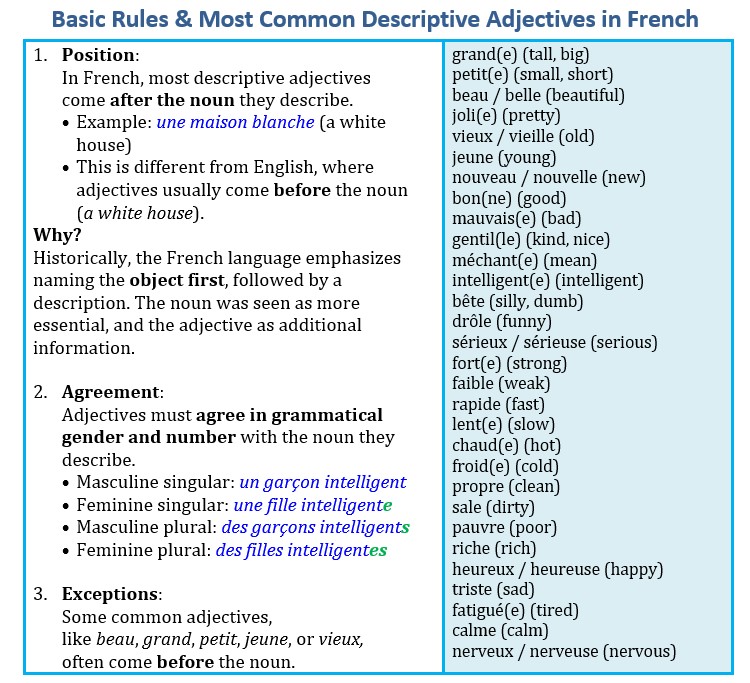
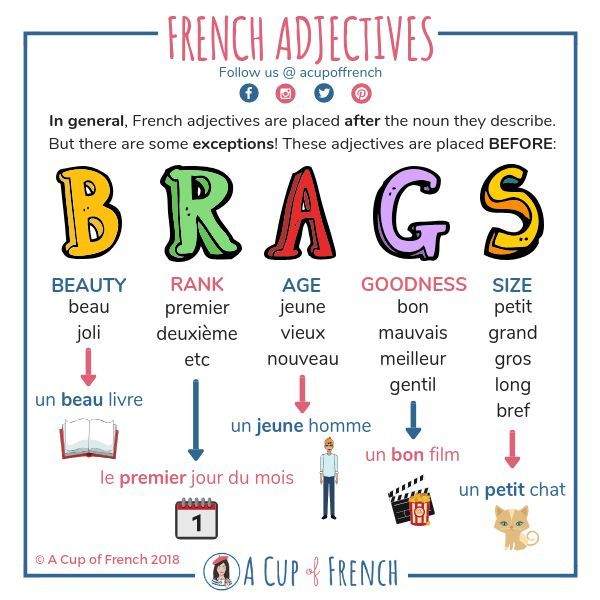
If you want to learn more of French adjectives, here is a great site with translations and audio recordings of 173 Essential French Adjectives | FluentU.
Practice
Les continents et leurs adjectifs. Ecoutez cette audio et et ensuite cochez (√ ) l’adjectif qui correspond au continent approprié.
Peux-tu trouver tous les adjectifs qui correspondent aux sept continents en français ?
Ecris les informations manquantes. N’oublie pas qu’il y a sept continents dans le monde : l’Afrique, l’Amérique du Nord, l’Amérique du Sud, l’Asie, l’Europe, l’Océanie et l’Antarctique.
Modèle: Le pays : la France.
Le continent : l’Europe La nationalité : française La langue : le français
3. Vous êtes un citoyen / une citoyenne du monde ?
Avec un·e partenaire ou en solo, complétez le tableau suivant en donnant le nom approprié :
|
une ville marocaine
|
une voiture allemande
|
| une célébrité anglaise
|
une série coréenne
|
| un acteur français
|
|
|
une ville japonaise |
|
Quelles sont leurs nationalités ? Avec un·e partenaire ou en solo, cherchez sur internet pour trouver la nationalité des personnes suivantes.
Modèle: Angèle ➡️ C’est une chanteuse belge. or Elle est belge.
- Omar Sy ➡️
- Demi Lovato ➡️
- Justin Bieber ➡️
- Gad Elmaleh ➡️
- Justin Trudeau ➡️
- Gims ➡️
- Votre prof de français ➡️
3.Carnet personnel✍️
To continue practicing your written communicaiton skills in French, it’s a great idea to invent conversations with imaginary partners from different countries because it helps you step outside your own cultural perspective. When you imagine what someone else might like—whether it’s food, music, movies, or influencers—you begin to develop empathy and curiosity about the world. This kind of creative thinking encourages you to do a bit of research, to learn about other cultures, and to reflect on how different people might have different tastes, values, and experiences. It also helps you realize that your preferences are not universal—and that’s a powerful step toward becoming more open-minded and globally aware. Plus, imagining these conversations builds your language skills in a fun and personal way!
Here are some questions that can be useful for building connections and learning more about others:
- Quel type de cuisine est-ce que tu préfères ? (iranienne, suisse, polonaise…)
- Quels films étrangers ou séries étrangères (=foreign) est-ce que tu regardes ?
- Quelle musique étrangère est-ce que tu écoutes ?
- Est-ce que tu suis (=follow) une influenceuse étrangère ou un influenceur étranger ? Comment ils s’appellent et d’où est-ce qu’ils sont ?
Instructions :
🌏✍️ Ecris une conversation avec un·e partenaire imaginaire d’un autre pays. Pose-lui les questions ci-dessous et invente ses réponses. Ensuite, écris aussi tes propres réponses. Cela te permet de comparer vos goûts culturels !
Exemple :
Quel type de cuisine est-ce que tu préfères ?
Partenaire imaginaire : Je préfère la cuisine libanaise, surtout le houmous et le taboulé.
Moi : Je préfère la cuisine polonaise, comme les pierogis.
Quels films étrangers ou séries étrangères est-ce que tu regardes ?
Partenaire imaginaire : Je regarde des séries coréennes comme Crash Landing on You.
Moi : Je regarde des films français, surtout ceux de François Ozon.
Quelle musique étrangère est-ce que tu écoutes ?
Partenaire imaginaire : J’écoute de la musique afrobeats, surtout Burna Boy.
Moi : J’écoute de la musique francophone, surtout les chansons de Stromae et d’Angèle.
Est-ce que tu suis une influenceuse étrangère ou un influenceur étranger ? Comment ils s’appellent et d’où est-ce qu’ils sont ?
Partenaire imaginaire : Oui, je suis une influenceuse japonaise qui s’appelle Naomi Watanabe.
Moi : Je suis un influenceur canadien qui s’appelle Matt D’Avella.
4. On écoute et on écrit : Le dictogloss
Practice
Voici la famille de Marc Amadou.
Écoutez la description de la famille de Marc et complétez les phrases suivantes. Listen to the audio and fill in the missing words. You can also repeat after the instructor to practice your French pronunciation.
Now, can you pronounce these phrases in French?
5. On s’éclate en chanson ! (Optionnel)
Here are five Francophone songs that explore countries, nationalities, and modern complex identities:
- “Les pays francophones” – Liz Syed. A fun and educational song listing all 29 officially French-speaking countries. 📺 YouTube video
- “Tékitoi” – Rachid Taha. One of his most famous songs, “Tékitoi” (a stylized version of T’es qui, toi ? or Who are you?), is a protest song that challenges stereotypes and questions identity, especially for North African immigrants in France.📺 YouTube video
- “Ave Cesaria” – Stromae. A tribute to Cape Verdean singer Cesária Évora, celebrating African and Lusophone identity. 📺 YouTube video
- “Je viens du sud” – Chimène Badi. A song about regional and cultural identity in France, expressing pride in one’s origins. It was first performed by Michel Sardou in the 1980s.📺 YouTube video 1 & YouTube video 2
- “Parce qu’on vient de loin” – Corneille. A heartfelt reflection on resilience, survival, and living each day fully, shaped by the trauma of war and the strength drawn from overcoming it. 📺YouTube video
 ♦
♦
Week 7 Day 2
On s’ouvre au monde : le mariage pour tous en Suisse
 ♦
♦
La Suisse
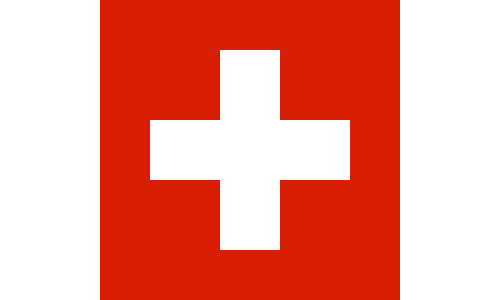 La capitale : Berne
La capitale : Berne
Les langues parlées : l’allemand, le français, l’italien, le romanche (1%)
La cuisine typique : la fondue au fromage, la raclette, les röstis
La fête nationale : le 1er août
The legal recognition of same-sex couples continues to evolve all over the world. Do you know if / when same-sex marriage was legalized in your country or state?
In 2021, the Swiss voted and decided to legally recognize marriage for all with 64% of votes in favor.
Watch the first 26 seconds of the video and select all the words from the list below that you hear. La Suisse approuve le mariage gay par un large “oui” | Euronews
Look at this photo from https://tetu.com/2021/09/06/suisse-referendum-mariage-pour-tous-septembre-manifestation-zurich/

Answer the following questions :
- What are the four languages spoken in Switzerland?
- Examine the sign in the photo and identify the language of each message.
- What is the literal translation of each of the messages? Use an online translator to translate each one. Don’t forget to change the language each time!
Yes, you probably noticed that in the photo, people are carrying a sign with the same message in all four official languages of Switzerland.
It’s the phrase traditionally used in wedding ceremonies when someone agrees to marry their partner—“Yes, I do.” Each language expresses it beautifully:
- German: Ja, ich will
- French: Oui, je le veux
- Italian: Sì, lo voglio
- Romansh: Gea, jau less
It’s a powerful way to show unity and support for marriage equality across cultures.
Now, explore this map : Mariage et union civile homosexuelle en Europe – 2021 and answer the following questions:
1. Do some research and explain what are the differences between Marriage and Union civil?
2. Look at the map and report the status of Marriage for all in the following countries and write the name of each country in French (do not forget to use the article with the name of the country in French):
On finit sur une bonne note !
You made it through chapter 2, now take a moment to assess your progress. Read each objective, try to perform the task and check it off mentally if you are able to do it:
After finishing this chapter, I can:
☐ describe my family by identifying the relationships or roles of its members, such as mother, father, and so on
☐ conjugate and use the verb to have-avoir
☐ tell what my family members or entourage do (professions, studies, etc.)
☐ count up to 1000
☐ explain and use different ways of counting in Francophone countries
☐ conjugate and use the -ER verbs
☐ talk about my pastime(s)
☐ talk about my family members’ pastime(s)
☐ ask questions to gather information about someone else
☐ explain some English words commonly used and accepted in French
☐ use interrogative adjectives (quel, quelle, etc.)
☐ use possessive adjectives (mon, ma, mes, etc.)
☐ tell time (in official and non-official formats)
☐ name the days of the week
☐ name the months of the year
☐ use yes/no questions (with intonation and est-ce que)
☐ form negation in simple sentences
☐ explain about ne-dropping in spoken French
☐ use adverbs (souvent, toujours, beaucoup, jamais, etc.)
☐ use descriptive adjectives and explain their placement
☐ name countries and continents
☐ tell someone about my nationality, and the nationalities of others
☐ explain about marriage in Switzerland
You can also complete this activity electronically and see how you do:
Level up !
In which areas of this chapter do you feel confident in your abilities?
In which areas do you feel less confident in your abilities?
Look back at the areas you felt less confident about in Chapter 1. Do you feel more confident in those areas now or about the same?
Media Attributions
- line
- 92329-text-photography-yellow-brain-light-stock
- Carnet-personnel
- Ma famille – tableau
- Je suis Kevin
- Les_âges_Yasmina
- Avoir-conj
- image26
- Cent-mille-rule
- Les_nombres-70-1000
- 9552380[1]
- danser-conj
- Ch2-LesJO
- Ch2-LesJO2
- Quels
- Adjectifs-possessifs
- Les heures
- Planning-hebdomadaire-semainier-imprimer
- French-adjectives-basic-rules
- French-adjectives


